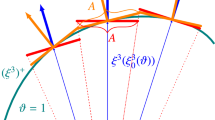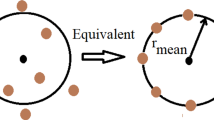Abstract
In this study, we present a novel finite element approach to simulate crack propagation in shell structures. A local spider-web mesh is placed at the tip of a crack propagating through a global background mesh. Interface shell elements with assumed natural strains are used to connect a non-matching interface between the background mesh and the local spider-web mesh. Interface shell elements are also employed for trimmed shell elements created by cutting shell elements with the crack line. Numerical simulation of crack propagation in shell structures can be easily performed by moving the local spider-web mesh with an incremental crack growth. Numerical experiments show that the present method is very efficient and effective to accurately simulate crack propagation in shell structures without significantly increasing computational burden and implementation complexity of remeshing process.
































Similar content being viewed by others
References
Moës N, Dolbow J, Belytschko T (1999) A finite element method for crack growth without remeshing. Int J Numer Methods Eng 46:131–150. https://doi.org/10.1002/(SICI)1097-0207(19990910)46:1%3c131:AID-NME726%3e3.0.CO;2-J
Dolbow J, Moës N, Belytschko T (2000) Modeling fracture in Mindlin-Reissner plates with the extended finite element method. Int J Solids Struct 37:7161–7183. https://doi.org/10.1016/S0020-7683(00)00194-3
Areias PMA, Belytschko T (2005) Non-linear analysis of shells with arbitrary evolving cracks using XFEM. Int J Numer Methods Eng 62:384–415. https://doi.org/10.1002/nme.1192
Bayesteh H, Mohammadi S (2011) XFEM fracture analysis of shells: the effect of crack tip enrichments. Comput Mater Sci 50:2793–2813. https://doi.org/10.1016/j.commatsci.2011.04.034
Larsson R, Mediavilla J, Fagerström M (2011) Dynamic fracture modeling in shell structures based on XFEM. Int J Numer Methods Eng 86:499–527. https://doi.org/10.1002/nme.3086
Zeng Q, Liu Z, Xu D et al (2016) Modeling arbitrary crack propagation in coupled shell/solid structures with X-FEM. Int J Numer Methods Eng 106:1018–1040. https://doi.org/10.1002/nme.5157
Benson DJ, Bazilevs Y, De Luycker E et al (2010) A generalized finite element formulation for arbitrary basis functions: from isogeometric analysis to XFEM. Int J Numer Methods Eng. https://doi.org/10.1002/nme.2864
De Luycker E, Benson DJ, Belytschko T et al (2011) X-FEM in isogeometric analysis for linear fracture mechanics. Int J Numer Methods Eng 87:541–565. https://doi.org/10.1002/nme.3121
Ghorashi SS, Valizadeh N, Mohammadi S (2012) Extended isogeometric analysis for simulation of stationary and propagating cracks. Int J Numer Methods Eng 89:1069–1101. https://doi.org/10.1002/nme.3277
Nguyen-Thanh N, Valizadeh N, Nguyen MN et al (2015) An extended isogeometric thin shell analysis based on Kirchhoff–Love theory. Comput Methods Appl Mech Eng 284:265–291. https://doi.org/10.1016/j.cma.2014.08.025
Areias PMA, Song JH, Belytschko T (2006) Analysis of fracture in thin shells by overlapping paired elements. Comput Methods Appl Mech Eng 195:5343–5360. https://doi.org/10.1016/j.cma.2005.10.024
Chau-Dinh T, Zi G, Lee P-S et al (2012) Phantom-node method for shell models with arbitrary cracks. Comput Struct 92–93:242–256. https://doi.org/10.1016/j.compstruc.2011.10.021
Chau-Dinh T, Mai-Van C, Zi G, Rabczuk T (2018) New kinematical constraints of cracked MITC4 shell elements based on the phantom-node method for fracture analysis. Eng Fract Mech 199:159–178. https://doi.org/10.1016/j.engfracmech.2018.05.045
Areias PMA, Belytschko T (2006) A comment on the article “A finite element method for simulation of strong and weak discontinuities in solid mechanics” by A. Hansbo and P. Hansbo [Comput. Methods Appl. Mech. Engrg. 193 (2004) 3523–3540]. Comput Methods Appl Mech Eng 195:1275–1276. https://doi.org/10.1016/j.cma.2005.03.006
Dirgantara T, Aliabadi MH (2000) Crack growth analysis of plates loaded by bending and tension using dual boundary element method. Int J Fract 105:27–47. https://doi.org/10.1023/A:1007696111995
Dirgantara T, Aliabadi MH (2002) Numerical simulation of fatigue crack growth in pressurized shells. Int J Fatigue 24:725–738. https://doi.org/10.1016/S0142-1123(01)00195-5
Xing C, Zhou C (2018) Finite element modeling of crack growth in thin-wall structures by method of combining sub-partition and substructure. Eng Fract Mech 195:13–29. https://doi.org/10.1016/j.engfracmech.2018.03.023
Bouchard PO, Bay F, Chastel Y, Tovena I (2000) Crack propagation modelling using an advanced remeshing technique. Comput Methods Appl Mech Eng 189:723–742. https://doi.org/10.1016/S0045-7825(99)00324-2
Bouchard PO, Bay F, Chastel Y (2003) Numerical modelling of crack propagation: automatic remeshing and comparison of different criteria. Comput Methods Appl Mech Eng 192:3887–3908. https://doi.org/10.1016/S0045-7825(03)00391-8
Funari MF, Lonetti P, Spadea S (2019) A crack growth strategy based on moving mesh method and fracture mechanics. Theor Appl Fract Mech 102:103–115. https://doi.org/10.1016/j.tafmec.2019.03.007
Murotani K, Yagawa G, Choi JB (2013) Adaptive finite elements using hierarchical mesh and its application to crack propagation analysis. Comput Methods Appl Mech Eng 253:1–14. https://doi.org/10.1016/j.cma.2012.07.024
Ooi ET, Man H, Natarajan S, Song C (2015) Adaptation of quadtree meshes in the scaled boundary finite element method for crack propagation modelling. Eng Fract Mech 144:101–117. https://doi.org/10.1016/j.engfracmech.2015.06.083
Khoei AR, Azadi H, Moslemi H (2008) Modeling of crack propagation via an automatic adaptive mesh refinement based on modified superconvergent patch recovery technique. Eng Fract Mech 75:2921–2945. https://doi.org/10.1016/j.engfracmech.2008.01.006
Colombo D, Giglio M (2006) A methodology for automatic crack propagation modelling in planar and shell FE models. Eng Fract Mech 73:490–504. https://doi.org/10.1016/j.engfracmech.2005.08.007
Nguyen-Thanh N, Li W, Zhou K (2018) Static and free-vibration analyses of cracks in thin-shell structures based on an isogeometric-meshfree coupling approach. Comput Mech 62:1287–1309. https://doi.org/10.1007/s00466-018-1564-y
Rashid MM (1998) The arbitrary local mesh replacement method: an alternative to remeshing for crack propagation analysis. Comput Methods Appl Mech Eng 154:133–150. https://doi.org/10.1016/S0045-7825(97)00068-6
Kim H-G (2002) Interface element method (IEM) for a partitioned system with non-matching interfaces. Comput Methods Appl Mech Eng 191:3165–3194. https://doi.org/10.1016/S0045-7825(02)00255-4
Kim H-G (2003) Arbitrary placement of local meshes in a global mesh by the interface-element method (IEM). Int J Numer Methods Eng 56:2279–2312. https://doi.org/10.1002/nme.648
Ho-Nguyen-Tan T, Kim H-G (2018) An interface shell element for coupling non-matching quadrilateral shell meshes. Comput Struct 208:151–173. https://doi.org/10.1016/j.compstruc.2018.07.008
Lim JH, Im S, Cho Y-S (2007) Variable-node elements for non-matching meshes by means of MLS (moving least-square) scheme. Int J Numer Methods Eng 72:835–857. https://doi.org/10.1002/nme.1988
Cho Y-S, Im S (2006) MLS-based variable-node elements compatible with quadratic interpolation. Part II: application for finite crack element. Int J Numer Methods Eng 65:517–547. https://doi.org/10.1002/nme.1452
Bathe K-J (1996) Finite element procedures, 2nd edn. Prentice Hall, Upper Saddle River
Sohn D, Im S (2013) Variable-node plate and shell elements with assumed natural strain and smoothed integration methods for nonmatching meshes. Comput Mech 51:927–948. https://doi.org/10.1007/s00466-012-0774-y
Hou Cheng Huang (1987) Implementation of assumed strain degenerated shell elements. Comput Struct 25:147–155. https://doi.org/10.1016/0045-7949(87)90226-4
Ko Y, Lee P-S, Bathe K-J (2017) A new MITC4 + shell element. Comput Struct 182:404–418. https://doi.org/10.1016/j.compstruc.2016.11.004
Ko Y, Lee P-S, Bathe K-J (2016) The MITC4 + shell element and its performance. Comput Struct 169:57–68. https://doi.org/10.1016/j.compstruc.2016.03.002
Stern M, Becker EB, Dunham RS (1976) A contour integral computation of mixed-mode stress intensity factors. Int J Fract 12:359–368. https://doi.org/10.1007/bf00032831
Yau JF, Wang SS, Corten HT (1980) A mixed-mode crack analysis of isotropic solids using conservation laws of elasticity. J Appl Mech 47:335–341. https://doi.org/10.1115/1.3153665
Nikishkov GP, Atluri SN (1987) Calculation of fracture mechanics parameters for an arbitrary three-dimensional crack, by the ‘equivalent domain integral’ method. Int J Numer Methods Eng 24:1801–1821. https://doi.org/10.1002/nme.1620240914
Zehnder AT, Viz MJ (2005) Fracture mechanics of thin plates and shells under combined membrane, bending, and twisting loads. Appl Mech Rev 58:37–48. https://doi.org/10.1115/1.1828049
Potyondy DO, Wawrzynek PA, Ingraffea AR (1995) Discrete crack growth analysis methodology for through cracks in pressurized fuselage structures. Int J Numer Methods Eng 38:1611–1633. https://doi.org/10.1002/nme.1620381003
Erdogan F, Sih GC (1963) On the crack extension in plates under plane loading and transverse shear. J Basic Eng 85:519–525. https://doi.org/10.1115/1.3656897
Sih GC (1974) Strain-energy-density factor applied to mixed mode crack problems. Int J Fract 10:305–321. https://doi.org/10.1007/BF00035493
Nuismer RJ (1975) An energy release rate criterion for mixed mode fracture. Int J Fract 11:245–250. https://doi.org/10.1007/BF00038891
Lee P-S, Bathe K-J (2004) Development of MITC isotropic triangular shell finite elements. Comput Struct 82:945–962. https://doi.org/10.1016/j.compstruc.2004.02.004
Sosa HA, Eischen JW (1986) Computation of stress intensity factors for plate bending via a path-independent integral. Eng Fract Mech 25:451–462. https://doi.org/10.1016/0013-7944(86)90259-6
Folias ES (1969) On the effect of initial curvature on cracked flat sheets. Int J Fract Mech 5:327–346. https://doi.org/10.1007/bf00190962
Acknowledgment
This work was supported by the National Research Foundation of Korea (NRF) grant funded by the Korea government (MSIT) (No. 2018R1A2B6006234).
Author information
Authors and Affiliations
Corresponding author
Additional information
Publisher's Note
Springer Nature remains neutral with regard to jurisdictional claims in published maps and institutional affiliations.
Rights and permissions
About this article
Cite this article
Ho-Nguyen-Tan, T., Kim, HG. Numerical simulation of crack propagation in shell structures using interface shell elements. Comput Mech 66, 537–557 (2020). https://doi.org/10.1007/s00466-020-01863-9
Received:
Accepted:
Published:
Issue Date:
DOI: https://doi.org/10.1007/s00466-020-01863-9




